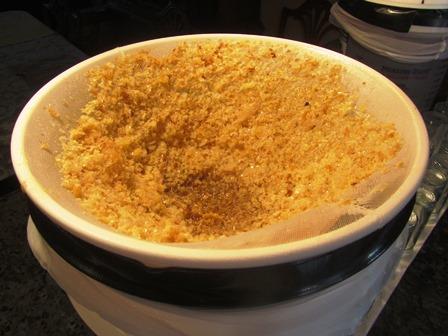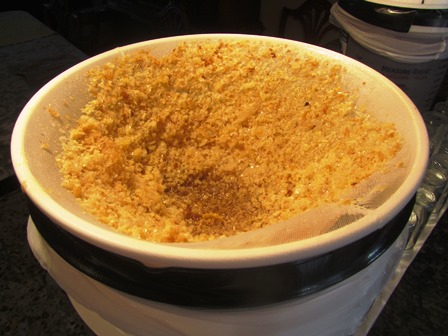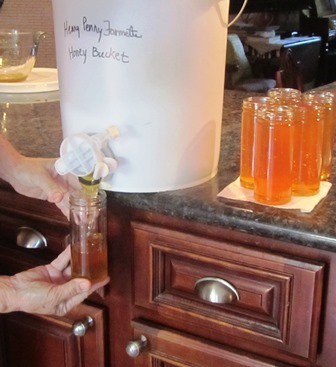First the Harvest, then the Floor
My kitchen floor was littered with bits of wax and bee glue yesterday. It took me over an hour on my knees to scrub and clean it after I had uncapped thirty frames of honey I’d taken from my hives.
In the process of scraping each frame and then unsealing all the capped cells on the front and back of each frame, drops of wax and propolis, or bee glue (created by the bees from bee saliva, wax, and exudate from botanical sources) fell to the floor. I tracked it from the counter, sink, and extractor on the soles of my shoes.
Even before I put my honey buckets under the extractor spigot, I tape fine mesh strainers over the buckets to catch wax and other debris.
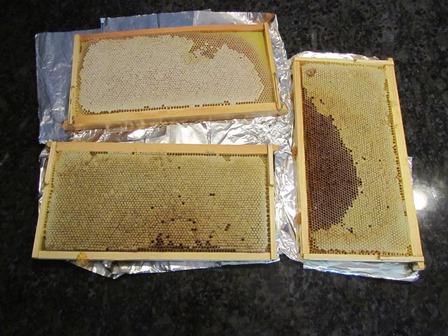
Three frames containing honey, but the sweet stuff is locked inside a honeycomb of cells sealed with wax by the bees
Once all the frames are processed and the buckets are sealed, I put the wax I’ve removed from the frames into a mesh bag to drain the honey (usually a much smaller quantity of honey is recovered from this process).
When the honey has been removed from the mesh bag, I place that wax on a cookie sheet and set it in the garden for the bees to clean. After the bees have cleaned all the wax (by eating any drops of honey left), I save the wax to melt into bars for candles or soap-making.
Back in in the kitchen, the extractor, it must be washed inside and out. Once cleaned and moved to the patio, I must start removing the wax and propolis from the floor. For that, I use an old thin, metal spatula to scrape the tile free of wax.
A soap and water scrub follows. Then I rinse and dry the floor with rags before moving the honey extractor back into the kitchen.
I won’t take honey again until next year. But now the honey must be bottled–that means I must sterilize bottles and prepare labels. Keeping honeybees is really only this labor intensive during and after the honey harvest. But the harvest is well worth all the work.
If you enjoy reading about farmette topics (including gardening, beekeeping, and delicious recipes), check out my cozy mysteries A BEELINE TO MURDER and also THE MURDER OF A QUEEN BEE in the Henny Penny Farmette series (from Kensington Publishing).
* * *
Enjoy reading about farming topics? Check out my cozy mysteries–A BEELINE TO MURDER and also THE MURDER OF A QUEEN BEE (both in the Henny Penny Farmette series from Kensington Publishing).
These novels are chocked full of recipes, farming tips, chicken and beekeeping tips, sayings and, of course, a charming cozy mystery. For more info, click on the links under the pictures.
The books are available through online retailers such as Amazon, Barnes & Noble, Kobo Books, and Walmart as well as from traditional bookstores everywhere.
See, http://tinyurl.com/hxy3s8q
This debut novel launched the Henny Penny Farmette series of mysteries and sold out its first press run. It’s now available in mass market paperback and other formats.
See, http://tinyurl.com/h4kou4g
NEWLY RELEASED! This, the second cozy mystery in the Henny Penny Farmette series, is garnering great reviews from readers and industry publications.
A Good Day to Strain, Drain, and Bottle Honey
It’s Sunday. I’m bottling the honey that I pulled from the hives last week. Yesterday, I washed two dozen eight-ounce jars in the dishwasher and allowed them to dry upside down on paper towels. Today, I’ll put on my apron and listen to some energetic big band tunes while I drain that honey into jars.
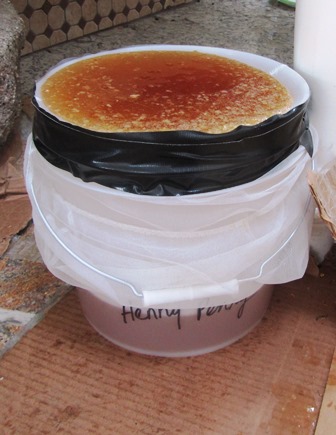
The fine mesh strainer taped tightly around the bucket rim traps the bits of wax but does not impede the flow of honey
My buckets of honey still have duct tape around their rims holding the strainers in position. When the honey was spun in the extracting machine, it had to be drained through a filter. Painter’s filters work great as the mesh cloth is very fine and fits over the top of the bucket.
The filter is placed into position around the rim and then duct taped is wrapped around tightly two times. Honey is quite heavy and can pull down the filter if not secured. I’m straining the honey that goes into jars. However, I did save back a jar of unfiltered honey with all those bits in it for a family member who prefers it that way.
The work was easier and went faster than I’d expected. It helps to have everything you need close at hand, clean, and ready to go.
Of the three large buckets, the first had a nice spigot than I could turn off after I allowed honey to flow and fill the jar. Then I closed the spigot, wiped the jar with a damp paper towel, and then screwed the lid in place.
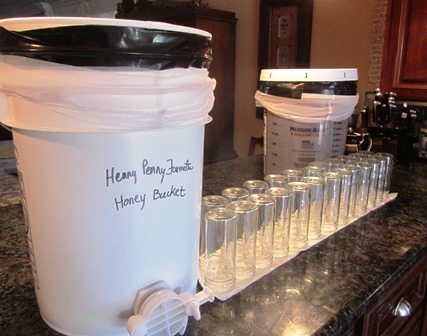
This five-gallon honey bucket will fill approximately five dozen eight-ounce jars; pictured here are 24 jars
The two dozen eight-ounce jars barely made a dent in my first honey bucket although my neighbor tells me that I can easily fill five dozen of the eight-ounce jars from one five-gallon bucket; or, I can fill two and one-half dozen of the sixteen-ounce jars.

Filled jars reveal clear, light amber honey the bees made from the French perfume lavender on my farmette and our springtime flowers, but these jars still labels
The next step in the process is to affix my Henny Penny label onto the jar. I plan to give some of these jars away during promotions in early October for my forthcoming novel, A BEELINE TO MURDER, the first in the Henny Penny Farmette series of cozies.
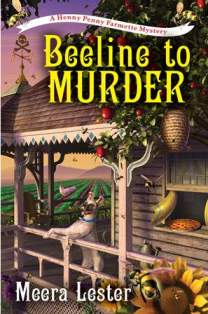
Published next month by Kensington, my book is available on Amazon, Barnes & Noble, and through most booksellers and online bookstores
If you are interested in this honey, please feel free to email me at meeralester1@gmail.com.
 Facebook
Facebook Goodreads
Goodreads LinkedIn
LinkedIn Meera Lester
Meera Lester Twitter
Twitter





